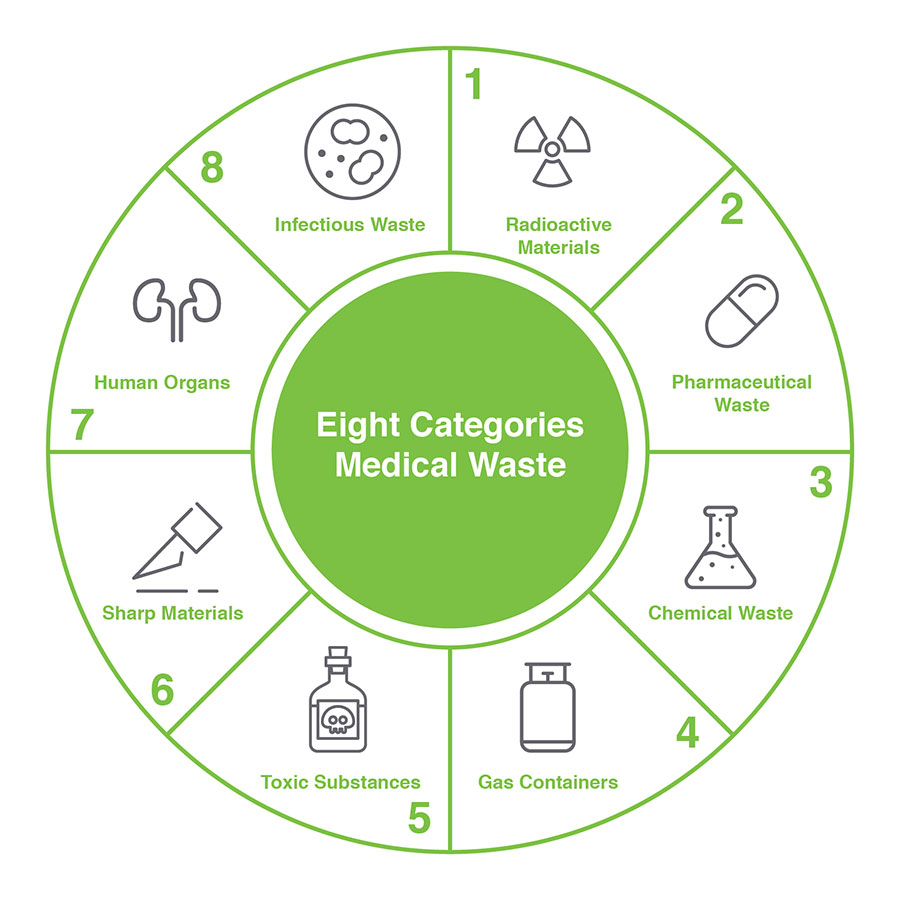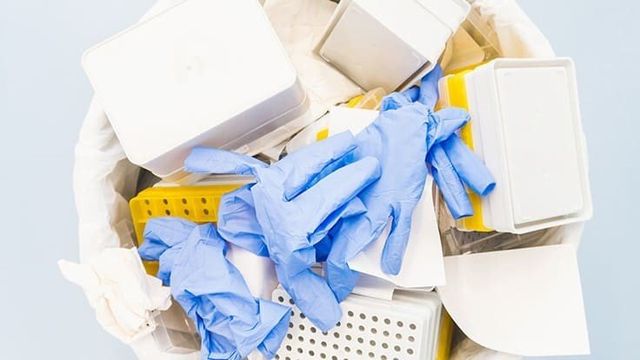Minimize Prices and Maximize Security: Effective Medical Waste Disposal Strategies
Effective medical garbage disposal strategies are crucial for health care facilities to reduce costs and maximize safety and security. With the expanding issue for environmental sustainability and the boosting variety of regulations bordering waste management, it is vital for health care organizations to embrace compliant and reliable methods. By carrying out correct partition and categorization, efficient packaging and labeling, secure transport and handling, efficient treatment and disposal approaches, and compliance with governing standards, healthcare facilities can guarantee the safe and accountable management of clinical waste. In this discussion, we will certainly discover each of these strategies thoroughly, offering insights and practical tips for medical care professionals to enhance their waste disposal processes.

Appropriate Segregation and Classification
Correct segregation and classification are crucial components of efficient clinical garbage disposal methods, guaranteeing the safety of medical care employees, the general public, and the atmosphere - medical waste removal. medical waste disposal services with WasteX. By dividing different kinds of clinical waste at the factor of generation, healthcare centers can reduce the danger of cross-contamination and potential injury to ecological communities and individuals
One of the crucial elements in appropriate partition is the recognition and category of medical waste. This includes classifying waste right into various groups, such as infectious, hazardous, contaminated, or pharmaceutical waste. Each category requires details handling, storage space, and disposal approaches to protect against any kind of damaging results on human health and wellness and the atmosphere.
In addition, correct segregation likewise includes making use of color-coded labels and containers to clearly determine and separate the different types of clinical waste. This helps healthcare workers and waste management employees to conveniently identify and take care of the waste properly. Red containers may be utilized for transmittable waste, while yellow containers may be designated for harmful waste.
In enhancement to segregation, appropriate classification additionally includes the proper packaging and containment of medical waste. This makes sure that waste is firmly stored and delivered without posing any kind of risks to individuals or the environment. Utilizing watertight and puncture-resistant containers, along with effectively securing and classifying them, helps to avoid any kind of accidental exposure or release of hazardous materials.
Efficient Product Packaging and Classifying
Effective packaging and labeling play an important duty in making certain the effective and secure disposal of clinical waste. Correct product packaging is important to protect against leak, damage, or splilling throughout transportation and handling. It assists to reduce the risk of contamination and protects medical care employees, waste administration workers, and the atmosphere from prospective risks.
Medical waste needs to be packaged in leak-proof and sturdy containers that are immune to puncture and damage. These containers must be correctly sealed to stop any kind of leak. Additionally, the product packaging must be able to hold up against the conditions of transport, including temperature variants and misuse.
Labeling is just as vital as it gives vital information concerning the components of the waste and any possible risks related to it. The labels should consist of the name of the health care center, the kind of waste, and any special delivery instructions. Clear and standard labeling makes sure that waste monitoring personnel can conveniently identify and manage the waste appropriately.
Reliable packaging and labeling likewise help in the proper segregation and classification of medical waste. Clear labeling enables easy recognition of various waste streams, such as infectious waste, sharps, or pharmaceutical waste. This aids in streamlining the disposal procedure and guaranteeing that the waste is dealt with or gotten rid of in conformity with regulatory standards.
Safe Transport and Handling
Ensuring the risk-free transport and handling of medical waste is of utmost significance in order to stop any potential health and wellness and ecological threats. Clinical waste, such as sharps, contaminated materials, and pharmaceutical waste, need to be correctly packaged and handled to explanation reduce the danger of direct exposure to hazardous compounds and microorganisms.
Delivering clinical waste requires compliance with strict guidelines and standards established by neighborhood authorities and ecological firms. These laws intend to shield the health and wellness of workers associated with waste management and protect against the launch of unsafe products right into the setting.
To make certain secure transport, clinical waste must be positioned in watertight and puncture-resistant containers that are appropriately secured and identified. These containers ought to be protected in a way that avoids spills or breakage during transportation (medical waste removal services). Furthermore, it is critical to use specific vehicles geared up with appropriate safety attributes to move clinical waste. These cars ought to have adequate air flow and be created to stop leak or contamination.
Managing clinical waste also requires appropriate training and adherence to safety and security protocols. Personnel included in the handling of medical waste ought to put on ideal personal protective devices (PPE) such as handwear covers, dress, and masks to decrease the threat of exposure. They should likewise comply with rigorous health techniques to stop the spread of infections and ensure the safe disposal of waste.
Efficient Therapy and Disposal Methods
Executing proper therapy and disposal approaches is crucial in managing medical waste effectively and minimizing potential health and environmental threats. Clinical waste, that includes sharps, contagious materials, chemicals, and pharmaceuticals, can pose significant hazards otherwise taken care of and disposed of properly. There are several therapy and disposal approaches readily available that stick to regulative guidelines and advertise secure methods.
One common method is incineration, which involves shedding the waste at high temperatures. Incineration works in damaging virus and lowering the quantity of waste, yet it can launch hazardous contaminants into the air if not correctly managed. For that reason, it is very important to use contemporary incinerators geared up with exhaust control modern technologies.
An additional approach is autoclaving, which makes use of vapor and stress to decontaminate the waste. Autoclaving is reliable in eliminating microorganisms and decreasing the volume of waste, yet it requires careful surveillance and upkeep to guarantee proper performance. The decontaminated waste can then be safely dealt with in a landfill.
Chemical therapy is one more option, which entails utilizing disinfectants or various other chemicals to reduce the effects of pathogens. This approach is frequently used for fluid waste, such as laboratory samplings. Nonetheless, it is essential to use proper chemicals and follow correct procedures to make certain efficient treatment and stop environmental contamination.

Compliance With Regulatory Standards
Complying with governing guidelines is vital in ensuring appropriate conformity with medical garbage disposal practices. These standards are implemented to secure public wellness, avoid ecological contamination, and keep workplace security. Conformity with governing guidelines is vital for medical care facilities, as non-compliance can lead to charges, penalties, and reputational damages.
Regulatory guidelines detail the correct handling, storage space, transport, and disposal of medical waste. They offer certain guidelines on product packaging requirements, labeling, and record-keeping. These guidelines likewise attend to the partition of various waste streams, such as sharps, contagious waste, and pharmaceutical waste. Medical care centers have to ensure that their waste monitoring techniques straighten with these standards to minimize the risk of exposure to hazardous materials and stop the spread of infections.
To keep conformity, health care facilities ought to establish extensive waste management programs that include team training, normal audits, and continuous this content tracking. It is necessary to maintain updated with any type of changes or updates to governing standards, as methods may develop over time. By staying notified and carrying out proper procedures, health care centers can lower the capacity for regulatory infractions and safeguard the health and wellness of their check that staff, patients, and the bordering neighborhood.
Conclusion
In final thought, carrying out effective clinical waste disposal strategies is critical for making the most of and decreasing expenses safety and security. Proper partition and categorization, reliable packaging and labeling, secure transportation and handling, and efficient treatment and disposal techniques are essential actions to ensure compliance with regulative guidelines. medical waste removal service. By sticking to these techniques, medical care facilities can safeguard the setting and public health while additionally reducing monetary worries associated with medical waste monitoring
By applying correct segregation and categorization, efficient packaging and labeling, secure transport and handling, reliable treatment and disposal techniques, and conformity with regulatory guidelines, health care centers can make certain the safe and accountable administration of clinical waste. Red containers might be made use of for infectious waste, while yellow containers may be designated for harmful waste.
Standard and clear labeling ensures that waste management personnel can quickly identify and deal with the waste properly. (medical waste disposal services with WasteX)
Clear labeling permits for very easy identification of different waste streams, such as transmittable waste, sharps, or pharmaceutical waste. These standards also address the partition of various waste streams, such as sharps, contagious waste, and pharmaceutical waste.